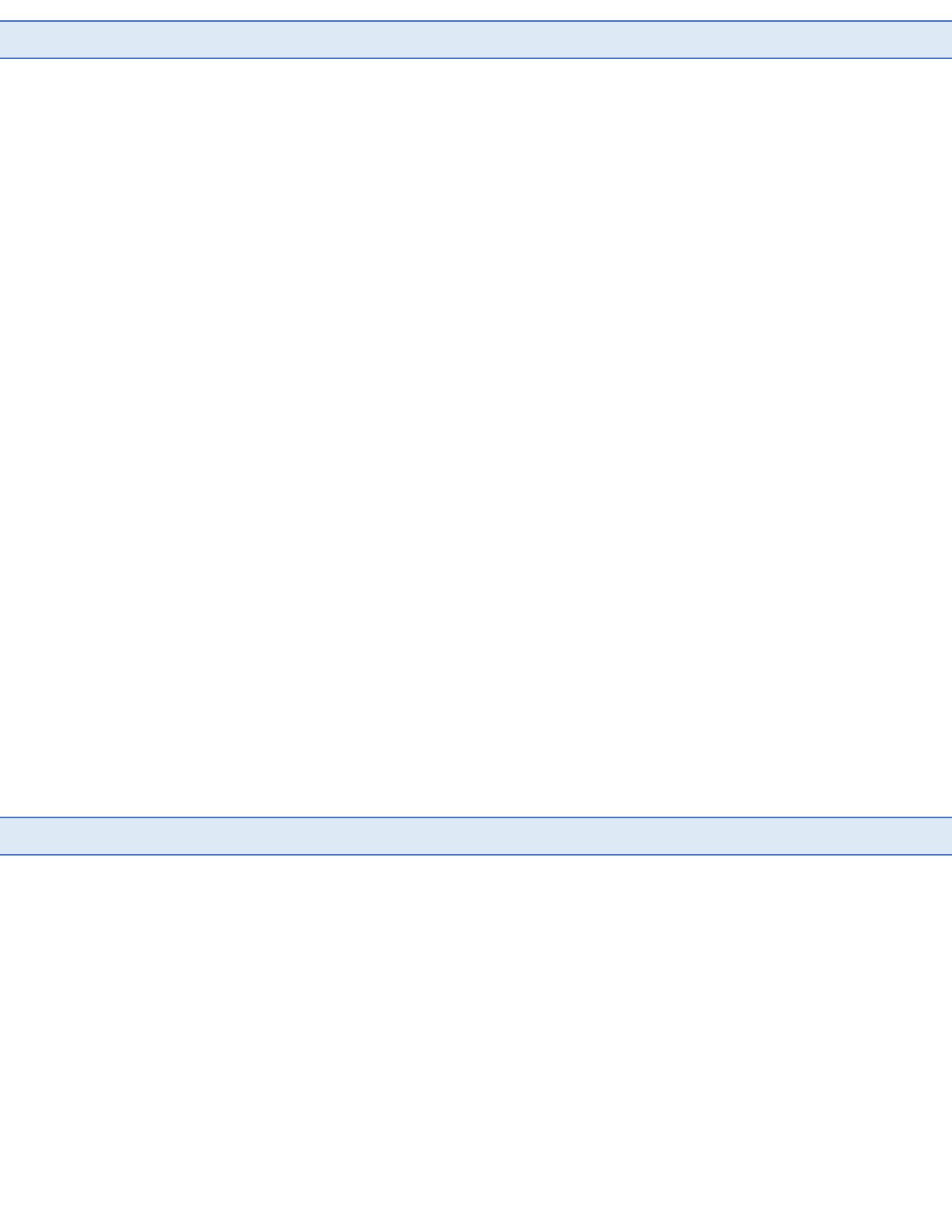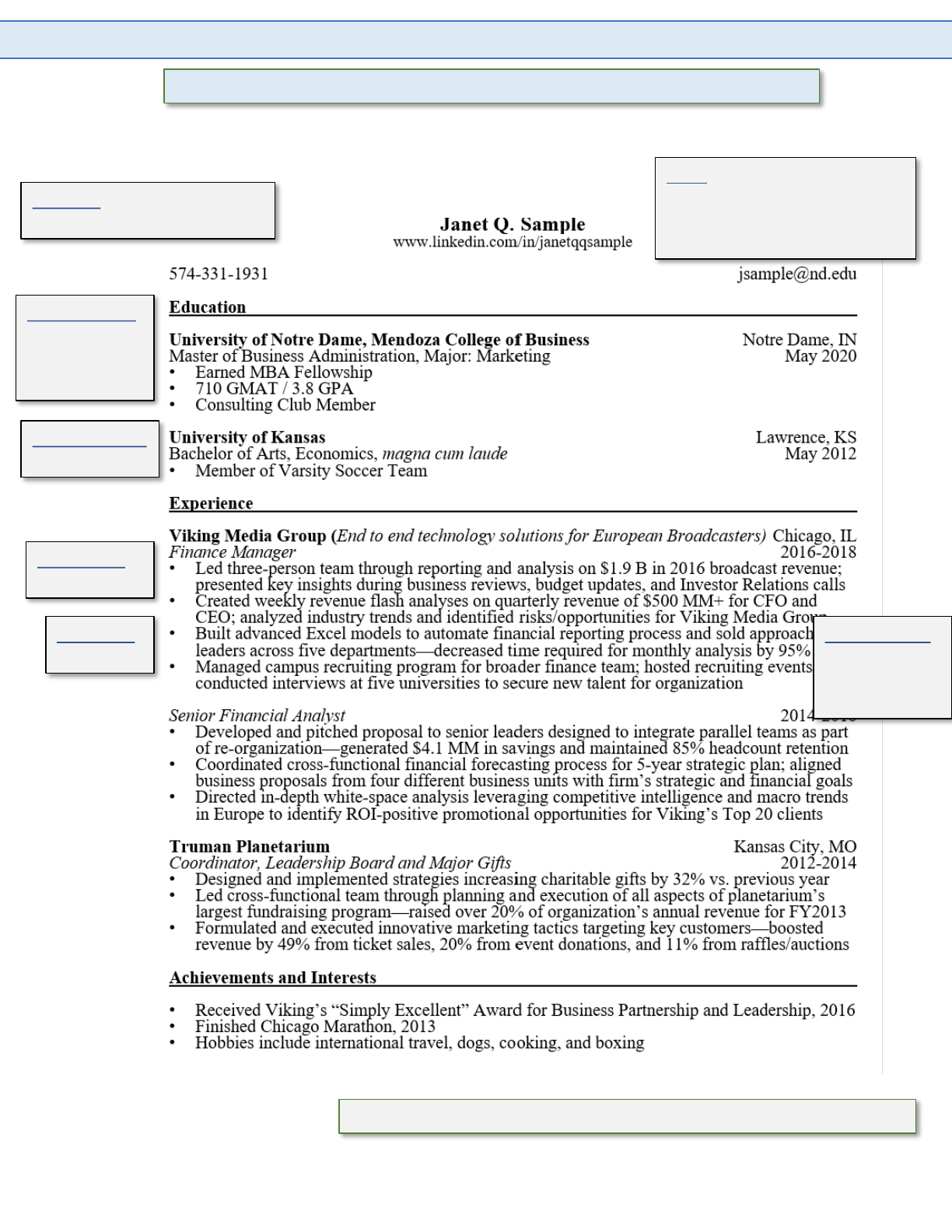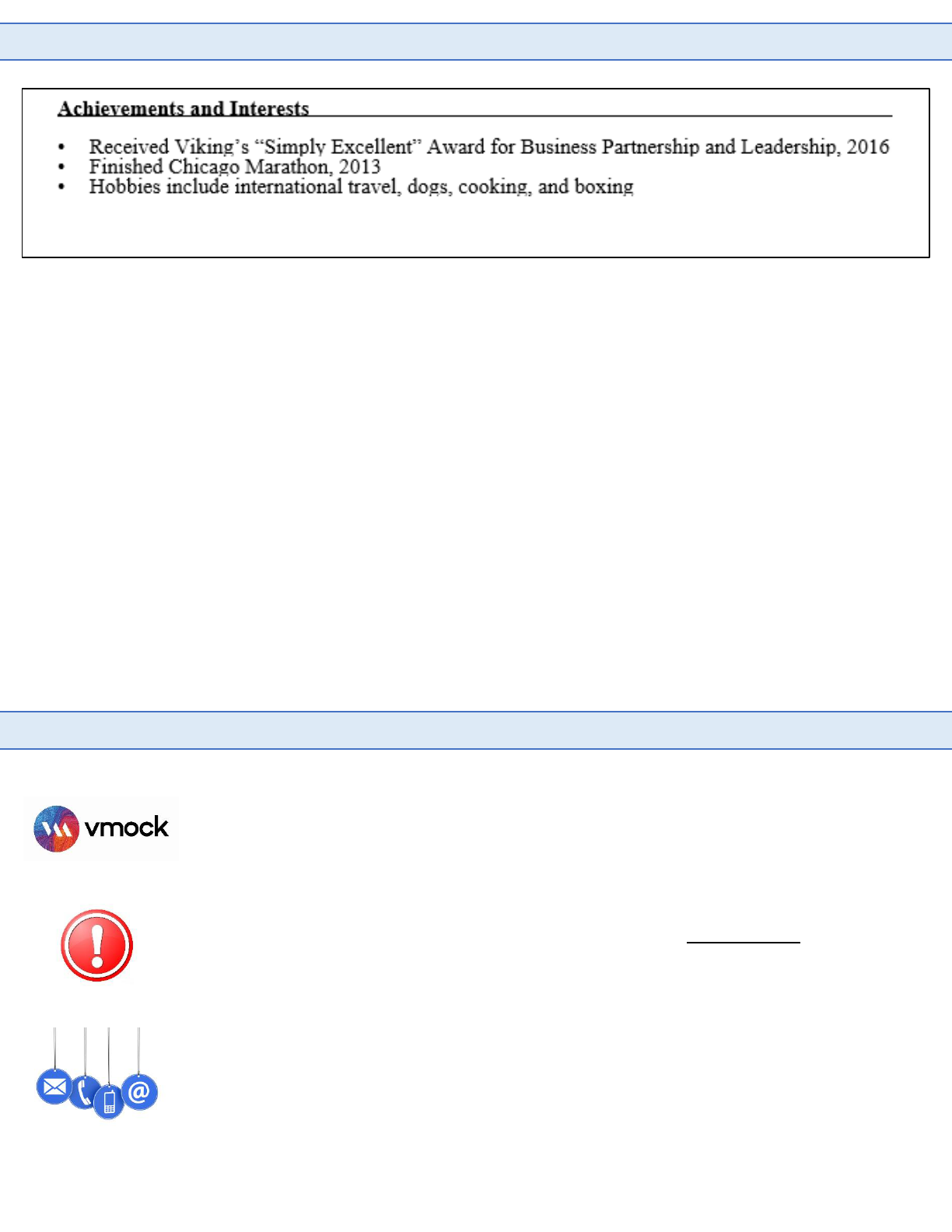
Notre Dame MBA
Résumé Guide
Graduate Business Career Development

YOUR RÉSUMÉ
Writing a résumé is a critical step in a successful job search strategy. Your résumé is your one-page personal selling
tool, and it may be the first impression you make with a potential employer. Writing your résumé also provides you
with an opportunity to assess your professional and personal experiences and think about what you accomplished,
why you made the decisions you did, what you liked (or didn’t like) about your choices, and how this all plays into
your career search going forward.
Ultimately, your résumé has one job: get you an interview.
For that reason, it is imperative that you spend some time to make your résumé as strong as possible. Here are
some things to think about as you write your résumé:
• Track Record of Success. With a résumé, your goal is to show that you have a track record of achieving big things
and making the places you’ve been better. As a result, your résumé should be focused on achievements (things
you accomplished and/or ways in which you added value to your organizations) rather than on responsibilities
(things you were responsible for). Bring your best!
• Relevant Highlights. A résumé is not a job description, nor is it a summary of everything you’ve ever done. A
good résumé is more about where you are going than where you have been. It is important to closely link your
past experience to the requirements of the job you are seeking and place emphasis on the parts of your
experience that are most applicable.
• Transferrable Skills. Employers want to know that you are capable of doing what they need, especially if you did
not hold a similar job in the past. So you want to sell your transferable skills – that is, core skills that can transfer
across various jobs, fields, and careers. Examples include managing people, analyzing data, leading teams,
creativity, communicating and presenting, and problem-solving.
• Key Competencies. Companies with formal recruiting programs compile a list of behaviors, technical skills, and
thinking and decision-making styles that are common among their top performers and required for a given
position (e.g., “oral communication”, “managing others”, and “initiative”). They use these criteria to evaluate
candidates when sorting through résumés and conducting interviews.
2
GETTING STARTED
Here’s what you’ll need to get started working on your résumé:
• Inspiration. Collect your thoughts and revisit your accomplishments by looking at past documents, such as:
• Business school applications and essays
• Previous résumés
• Performance evaluations
• Project reports from work
• ND MBA Résumé Template. You can view and download a Word version of the résumé template via Vmock.
• This Résumé Guide. Review the remaining pages of this guide for tips on creating a high-impact MBA résumé.

WHY A RÉSUMÉ TEMPLATE?
WHY A SINGLE PAGE?
RISKS ASSOCIATED WITH DEVIATING FROM THE TEMPLATE
Most (if not all) top MBA programs ask students to use a specific résumé template, and those templates tend to
look very similar. Why?
Because your résumé should be about the content.
Using a template means you don’t have to spend your time worrying about things like which sections go where,
page margins, formatting, etc. Instead, you can spend your time making your content as strong as possible.
Our recruiting partners are also familiar with, and like, our résumé template. The structure makes each résumé easy
to read, and they know exactly where to look to find the things they’re looking for. In that sense, deviating from the
résumé template comes with some degree of risk—and that’s something you generally want to avoid.
Recruiters expect MBA candidates to have a one-page résumé, for several reasons:
• It shows you can be concise (by keeping your résumé short)
• It shows you can be strategic (by smartly choosing what stays…and what goes)
• It shows you’re focused on the reader—and not yourself (by only including content relevant to him or her)
• It remains the industry standard for top MBA programs.
Because they have limited time, and have to review so many résumé, some employers are very rigid about this. For
example, based on feedback from dozens of Fortune 100 recruiting partners, the MBA Veterans Conference website
automatically rejects résumé that are longer than a single page. Many companies have similar policies. CVs can be
shared if asked for, but rarely do you see this in the MBA space.
Finally, a one-page résumé is much easier to manage and hand out when meeting people in person. You don’t want
to be the only candidate handing out two-sided (or, worse yet, stapled) résumés to potential employers. Again, in
this regard, deviating from the template comes with some degree of risk.
As previously mentioned, deviating from the résumé template comes with some degree of risk. That works against
your goal as a job seeker, which is to eliminate as much risk from the process as possible.
Choosing to deviate from the template may communicate less-than-desirable attributes to a potential employer.
When this goes wrong, it can go really wrong. A recent ND MBA grad decided to take a different approach with his
résumé while working through the job search process, and didn’t have a lot of success. A recruiter from Procter &
Gamble found his approach especially questionable and shared this feedback with the Career Services team:
“He won’t be getting an interview, in large part because of the résumé. The format definitely stood out, but not in
the way that he may have hoped. Honestly, what it said to me was: This guy has trouble accepting advice that an
idea of his needs to be improved. It came off as a lack of self-awareness and/or lack of collaboration with experts.”
This MBA student eliminated himself as a candidate before interviewing for the role by positioning himself as a
somebody who may be hard to work with. That’s certainly not what he intended, but once you hit “send” on a
resume, there’s no telling how your audience will receive it. That’s why it’s best to eliminate risk whenever possible.
3

ND MBA RÉSUMÉ TEMPLATE
Margins:
• 0.5-1.0 inches on all sides
Font:
• Times New Roman
• 14-pt for name
• 10.5-12-pt for other content
Section Titles:
• Bold
• Underlined
• Align Left
School Names:
• Bold
Dates/Places:
• Align Right
(all other
content left)
Co. Names:
• Bold
Job Titles:
• Italics
Blank Lines Between All Section Titles, New Sections, and Jobs
4
MBA/MSBA, 5 year student representative education section at end of guide

Overall:
• Font type: Times New Roman
• Font size for Body: 10.5 - 12-pt
• Margins: 0.5 – 1.0 inches on all sides
• Blank space between all sections titles, new sections, and new jobs
Alignment:
• Content: Align Left
• Dates/Places: Align Right
Education Section:
• Listing Clubs under Education: list all on one line preferably
• GMAT optional: recommend only if 700 or above, do not include Q/V scores
• GPA optional
• Bullets under “Education”: no more than 3
• Graduate with honors: put on same line as degree in lower case and italics (i.e. summa cum laude)
Experience Section:
• Description of company, if needed: Same line of company name, in parentheses and in italics.
• No sub bullets
• Dates: Months not required with years unless same year (i.e. 2016 - 2017, Apr 2017 - July 2017)
• Promotions: if listed, should be placed last within the appropriate section
Achievement and Interests Section:
• Bullets under “Achievements and Interests”: no more than 4
• Work authorization: not required, encouraged if there is unique work authorization
• Full Name
• LinkedIn URL (be sure to customize this)
PERSONAL INFORMATION
• Keep the header balanced with the information that you do provide
KEY RESUME ATTRIBUTES
• Preferred Phone Number
• School Email Address ONLY
5

EDUCATION
• Start with your Notre Dame MBA
• Listing your major(s) is optional, but encouraged
• Include no more than 3 bullets to show achievement and/or involvement as a
student
• List other degrees in reverse chronological order (i.e., most recent at top)
• Include no more than 2 bullets to show achievement and/or involvement as a student
• Don’t overshadow your MBA entry (i.e., don’t give the impression that you were super involved as
an undergrad…and only go to class as an MBA)
Not sure what to include for your Education entries?
Again, your goal is to show a track record of success, so highlight things that show achievement and/or
engagement as a student. Some things to consider include the following:
• GMAT optional, recommend including only if score is 700 or higher, but no Q/V scores
• GPA is also optional
• Academic Distinctions (Dean’s List, cum laude, etc.)
• Merit-based awards/fellowships – do not include money amount
• Involvement with significant student clubs/activities but recommend listing on one line
This section will evolve during your time as a student, so don’t worry about including things like “Consulting Club
Member” during the first semester of your first year. Recruiters just want to see that you’re doing what you can
to get involved, learn more about your preferred career path, and prepare yourself to be successful within it.
6

7
EXPERIENCE
• Shoot for 3-4 high-impact bullet points per role
• Try to keep individual bullet points to 1-2 lines; but 3 is ok
• Unless you have a compelling reason to do so,
you generally don’t need to include months
• Bullet points should start with strong action verbs (Led, Managed, Developed, etc.)
• All bullet points should be in past tense (unless you will still be in the role as a student)
WRITING STRONG RÉSUMÉ BULLET POINTS
Writing bullet points for the Experience section is where you will spend most of your time when working on your
résumé. As you review past accomplishments, think of everything you’ve done in terms of “stories”:
• What was the problem you addressed?
• What actions did you take?
• What were the results of your actions?
Structuring your résumé in this way will help the document be more achievement-oriented and will also prepare
you to speak succinctly about your experiences in interviews.
Thinking in terms of stories and results will also help you avoid a résumé that reads like a generalized job
description (e.g., “Responsible for purchasing, logistics and distribution”). You need specifics – numbers,
percentages, details – that show results and communicate how well you performed (e.g., “Managed and led a team
of six in cost reduction
initiatives that reduced labor costs by 12%, overtime by 24% and material waste by 43%”).
Even if the reader doesn’t have experience in your particular industry or function, you want him or her to be able to
tell that you did something significant…and that the organization was better off because you were part of it.
• To indicate the impact of your hard work
use words like decreased/decreasing,
generated/generating

8
ACHIEVEMENTS & INTERESTS
This section rounds you out as an individual, beyond your professional and educational accomplishments. Things
you include in this section can help form a good first impression, and it’s not uncommon for recruiters to ask
interview questions about your achievements and/or interests.
Some tips for this section:
• This is a good place to include language abilities, dual or international citizenship, community service,
professional memberships or societies, extracurricular activities, and unique interests.
• Whenever possible, list specific interests. For example, instead of “music and hiking,” write “play classical guitar;
avid High Sierras backpacker.”
• Avoid repeating information that appeared elsewhere in your résumé.
• Include your work authorization status so employers understand any sponsorship needs you may have.
• Do not include personal or family information (marital status, birth date, etc.) .
ADDITIONAL RESOURCES
VMock Smart Résumé Platform. Our team will provide you with additional details regarding
VMock‘s virtual résumé review tool at a later date. After uploading your résumé, VMock will
evaluate it in three areas (Impact, Presentation, and Competencies) and even provide bullet
point-level feedback to help you make your résumé stronger.
You can upload your resume directly as is and it will put your resume into our template.
185 Powerful Verbs That Will Make Your Resume Awesome. Follow this link to view the list
(courtesy of themuse.com).
ND Graduate Business Career Services Team Contact Info:
Telephone: 574-631-3315
E-Mail: [email protected]

Career Gap
A career gap is time spent away from the workforce. Reasons for career gaps include, taking care of a family, taking
a sabbatical, or being laid off.
Frame the explanation of your gap under the Experience section in a way that highlights your skills, achievements,
and experience.
If you did volunteer work during this time period that allowed you to build relevant skills and/or gain industry
knowledge, create an entry for this experience.
If you did freelance work for multiple clients over a period of time, group these positions together under one
position and combine the dates.
If you took a sabbatical to take some downtime, be a caregiver, or raise your children, create an entry that says
“Sabbatical” or “Planned Career Break”. You can include bullets under this listing, but it is not necessary. You just
want to be prepared to talk about it in an interview. Examples: Intentionally left workforce to raise children who no
longer need full-time support, now excited to return to work; Left workforce in 2015 to care for ill parent and am
now returning to work.
3

ND MBA/MSBA EDUCATION EXAMPLE
Have separate listings for both your MBA and undergraduate degree
ND MBA/ND Undergrad Dual EDUCATION EXAMPLE
10
Degree:
• Do not use all abbreviations, i.e. MBA/MSBA

FUNCTIONAL CONSIDERATIONS
9
Corporate Finance/Investment Banking
• Completion of Training the Street modules if applicable; list in Achievements and Interests
• Any other outside coursework such as Wall Street Prep or online courses that support the move to Finance; list
in Achievements and Interests
• In a previous non-finance job, use bullets that tap into finance-like duties, such as budgeting, forecasting,
performance tracking (eg. in operations or engineering positions)
• Do not forget designations completed or in progress such as CPA, CFA, CFP, etc.; list in Achievements and
Interests
General Management
• Use bullets to tap into leadership (formal or informal) experience, show working across disciplines and functions
• Examples of managing projects or leading teams useful as bullets, especially for LDPs
Marketing:
• Use bullets to demonstrate any experience with segmentation strategies, consumer insights, Nielsen or IRI
analysis, i.e. specific marketing skills.
